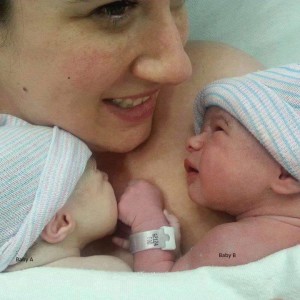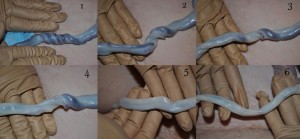You may have seen this article popping up on social media recently, about UK midwife Amanda Burleigh finally winning her campaign to change the guidelines regarding clamping and cutting of the umbilical cord. The guidelines now recommend waiting AT LEAST one minute before clamping.
You may wonder, “What’s the big deal? Does it REALLY matter when the cord is cut?”
While the effects of immediate cord clamping may not be life threatening, and in some cases immediate clamping is necessary, these cases should be the minority. Unless early clamping is required in a lifesaving situation, waiting at least one minute after delivery, should, and now hopefully will be the norm.
The following picture shows a Mama with her newborn twins. Twin A had the umbilical cord clamped almost immediately while Twin B had delayed cord clamping. This is a great side by side visualisation to demonstrate the difference in colouring when baby has been able to receive a higher blood volume.
Studies have shown that at birth, up to 32% of the babys blood volume can still be held in the umbilical cord and placenta! By allowing time for the cord to cease pulsing, you can help ensure your baby receives an incredible iron boost. Studies such as this also suggest babies whose cords are clamped after one minute generally had a higher birthweight, early haemoglobin concentration, and increased iron reserves up to six months after birth. Cord blood also contains important stem cells, so it is beneficial for your baby to receive these. It is thought that delayed clamping may slightly increase the risk of jaundice, but this is usually very easily managed.
How will you know when the cord has ceased pulsating?
The following image shows a series of photos, taken in sequence within a space of 15 minutes.
The difference is astounding, and you can actually see that the cord is no longer filled with blood.
There are lots of articles outlining the benefits of delaying cord clamping, and a simple internet search will bring a wealth of information.
I invite you to research this further, and to discuss your ideas with your caregivers. You can absolutely include this request in your birth plan and in my experience staff will happily oblige if practical.
Copyright © 2016 Jessica Nash. All Rights Reserved. If sharing please give credit to original post.



